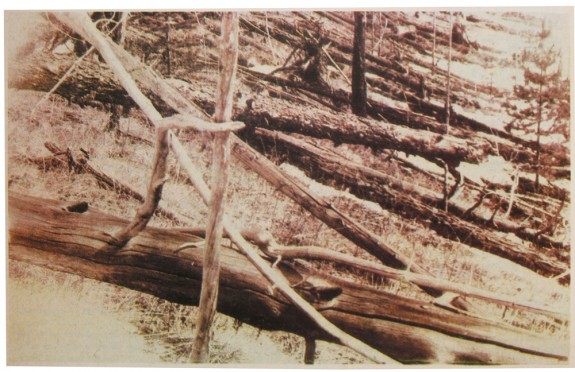The Last Massive Exploding Meteor Hit Earth in 1908, Leveling 800 Square Miles of Forest
In 1908, a meteor exploding in mid-air released the energy equivalent to “185 Hiroshima bombs”

Trees blown over by the shock wave of the 1908 Tunguska meteor. Photo: Vokrug Sveta / Wikimedia Commons
Early this morning in Russia, when a meteor broke up a few dozen kilometers above ground, its supersonic flight and mid-air death generated shock waves that rattled houses, broke windows, and sent dozens to the hospital. The meteor’s break-up released energy equivalent to a few hundred thousand tons of TNT. But while it was surely scary for those whose heads it passed over, compared to a disaster that took place a few thousand miles to the east more than 100 years ago, today’s meteor was rather puny.
On June 30, 1908, says NASA, a truly massive meteor exploded near the Podkamennaya Tunguska River in Siberia. The explosion sent out a shockwave that decimated the region. Now known as the Tunguska event, an expedition to the area made in 1921, says the Guardian, “laid bare the devastation caused by impact, with 80m of trees levelled over 830 square miles (2,150 sq km).”
Like today’s Russian meteor, the Tunguska meteor was thought not to have hit the ground in a conventional impact, but rather to have exploded above the ground. The Tunguska meteor, however, was much bigger, and its explosion was likely much nearer to the surface. “he combination of pressure and heat caused the asteroid to fragment and annihilate itself, producing a fireball and releasing energy equivalent to about 185 Hiroshima bombs,” says NASA.
The massive explosion packed a wallop. The resulting seismic shockwave registered with sensitive barometers as far away as England. Dense clouds formed over the region at high altitudes which reflected sunlight from beyond the horizon. Night skies glowed, and reports came in that people who lived as far away as Asia could read newspapers outdoors as late as midnight. Locally, hundreds of reindeer, the livelihood of local herders, were killed, but there was no direct evidence that any person perished in the blast.
Though recent research has claimed both to have unveiled an impact crater for the Tunguska event and to have pinned the explosion on a dust- and gas-rich comet, NASA says that the most widely-accepted explanation is that it was an exploding meteor.
More from Smithsonian.com:
Massive Meteor Breaks Up Over Russia, Sends Dozens to Hospital
/https://tf-cmsv2-smithsonianmag-media.s3.amazonaws.com/accounts/headshot/smartnews-colin-schultz-240.jpg)
/https://tf-cmsv2-smithsonianmag-media.s3.amazonaws.com/accounts/headshot/smartnews-colin-schultz-240.jpg)